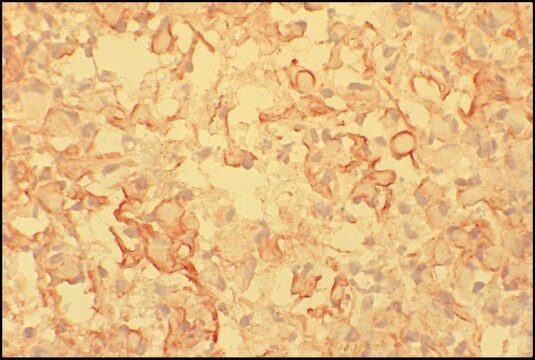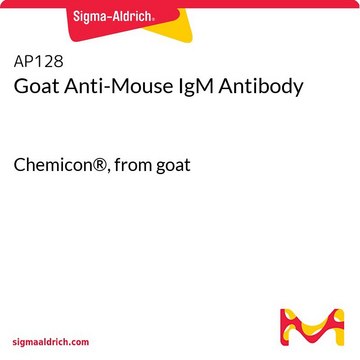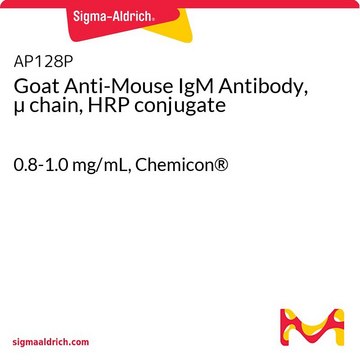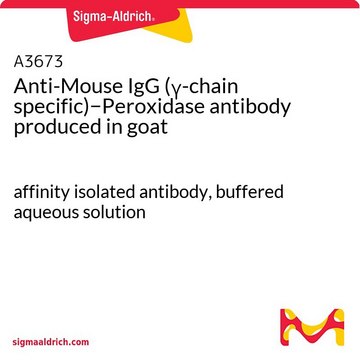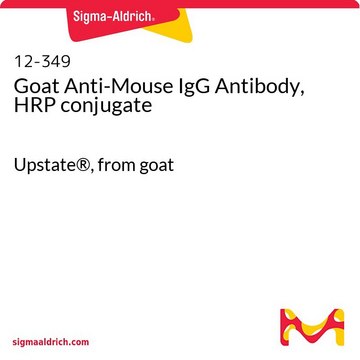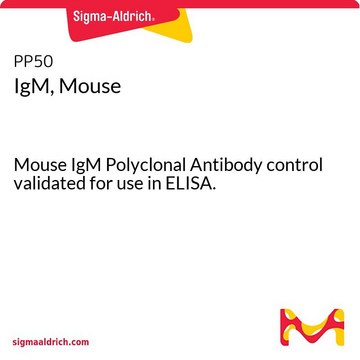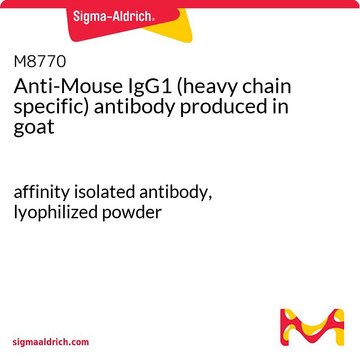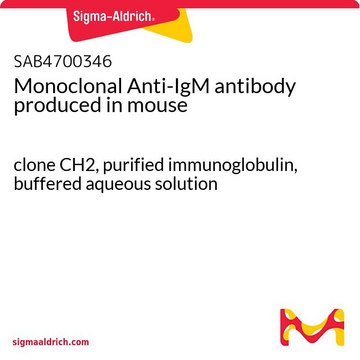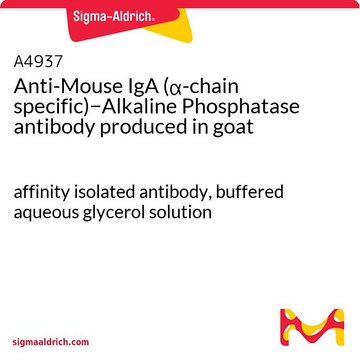M8644
Anti-Mouse IgM (μ-chain specific) antibody produced in goat
affinity isolated antibody, lyophilized powder
Synonym(s):
Goat anti-mouse IgM
Sign Into View Organizational & Contract Pricing
All Photos(1)
About This Item
Recommended Products
biological source
goat
Quality Level
conjugate
unconjugated
antibody form
affinity isolated antibody
antibody product type
secondary antibodies
clone
polyclonal
form
lyophilized powder
technique(s)
indirect ELISA: suitable
storage temp.
2-8°C
target post-translational modification
unmodified
Looking for similar products? Visit Product Comparison Guide
Related Categories
General description
Mouse serum-derived IgM may be used as a reference antigen, standard, blocking agent, or coating protein in a variety of immunoassays including ELISA, dot immunobinding, Western immunoblotting, immunodiffusion, and immunoelectrophoresis. Other applications include starting materials for the preparation of immunogens and solid phase immunoadsorbents.
Immunoglobulin M (IgM) antibodies appear early in the course of infections. IgM antibodies are responsible for agglutination of red blood cells in mis-matched blood transfusions. The level of IgM may vary with the status of disease or infection.
Immunoglobulin M (IgM) antibodies appear early in the course of infections. IgM antibodies are responsible for agglutination of red blood cells in mis-matched blood transfusions. The level of IgM may vary with the status of disease or infection.
Specificity
Goat polyclonal anti-Mouse IgM (μ-chain specific) antibody reacts with the m-chain of mouse IgM. It is s specific for mouse IgM when tested against purified mouse IgA, IgG1, IgG2a, IgG2b, IgG3, and IgM, myeloma proteins.
Application
Applications in which this antibody has been used successfully, and the associated peer-reviewed papers, are given below.
Chromatin immunoprecipitation (1 paper)
Enzyme-linked immunosorbent assay (1 paper)
Chromatin immunoprecipitation (1 paper)
Enzyme-linked immunosorbent assay (1 paper)
Goat polyclonal anti-Mouse IgM (μ-chain specific) antibody may be used to identify and quantitate the level of mouse IgM in vitro and in human serum or other biological fluids by immunochemical or immunohistological techniques.
Physical form
Lyophilized from 0.01 M sodium phosphate, 0.015 M sodium chloride, pH 7.2
Reconstitution
Reconstitute with 0.135 M sodium chloride.
Disclaimer
Unless otherwise stated in our catalog or other company documentation accompanying the product(s), our products are intended for research use only and are not to be used for any other purpose, which includes but is not limited to, unauthorized commercial uses, in vitro diagnostic uses, ex vivo or in vivo therapeutic uses or any type of consumption or application to humans or animals.
Not finding the right product?
Try our Product Selector Tool.
Storage Class Code
13 - Non Combustible Solids
WGK
WGK 1
Flash Point(F)
Not applicable
Flash Point(C)
Not applicable
Personal Protective Equipment
dust mask type N95 (US), Eyeshields, Gloves
Choose from one of the most recent versions:
Already Own This Product?
Find documentation for the products that you have recently purchased in the Document Library.
Customers Also Viewed
D E Macfarlane et al.
Journal of immunology (Baltimore, Md. : 1950), 160(3), 1122-1131 (1998-05-07)
Phosphorothioate oligodeoxynucleotides containing CpG (CpG-ODN) activate immune responses. We report that quinacrine, chloroquine, and structurally related compounds completely inhibit the antiapoptotic effect of CpG-ODN on WEHI 231 murine B lymphoma cells and inhibit CpG-ODN-induced secretion of IL-6 by WEHI 231.
Yasmine Zouggari et al.
Nature medicine, 19(10), 1273-1280 (2013-09-17)
Acute myocardial infarction is a severe ischemic disease responsible for heart failure and sudden death. Here, we show that after acute myocardial infarction in mice, mature B lymphocytes selectively produce Ccl7 and induce Ly6C(hi) monocyte mobilization and recruitment to the
D E Macfarlane et al.
Immunology, 91(4), 586-593 (1997-08-01)
Certain oligodeoxynucleotides (ODN) containing cytosine followed by guanosine (CpG) protect B cells from apoptosis, and induce B-cell proliferation and cytokine production. We investigated the effect of phosphorothioate CpG-containing ODNs (5'-ATAATCGACGTTCAAGCAAG-3' or 5'-TCCATGACGTTCCTGACGTT-3') and control ODNs (which did not contain CpG)
Andrew Elvington et al.
Journal of immunology (Baltimore, Md. : 1950), 189(9), 4640-4647 (2012-10-03)
There is mounting evidence indicating an important role for complement in the pathogenesis of cerebral ischemia-reperfusion injury, or ischemic stroke. The role of the alternative complement pathway in ischemic stroke has not been investigated, and there is conflicting data on
Tanel Punga et al.
EMBO molecular medicine, 2(4), 120-129 (2010-04-08)
Friedreich ataxia is a degenerative disease caused by deficiency of the protein frataxin (FXN). An intronic expansion of GAA triplets in the FXN-encoding gene, FXN, causes gene silencing and thus reduced FXN protein levels. Although it is widely assumed that
Our team of scientists has experience in all areas of research including Life Science, Material Science, Chemical Synthesis, Chromatography, Analytical and many others.
Contact Technical Service